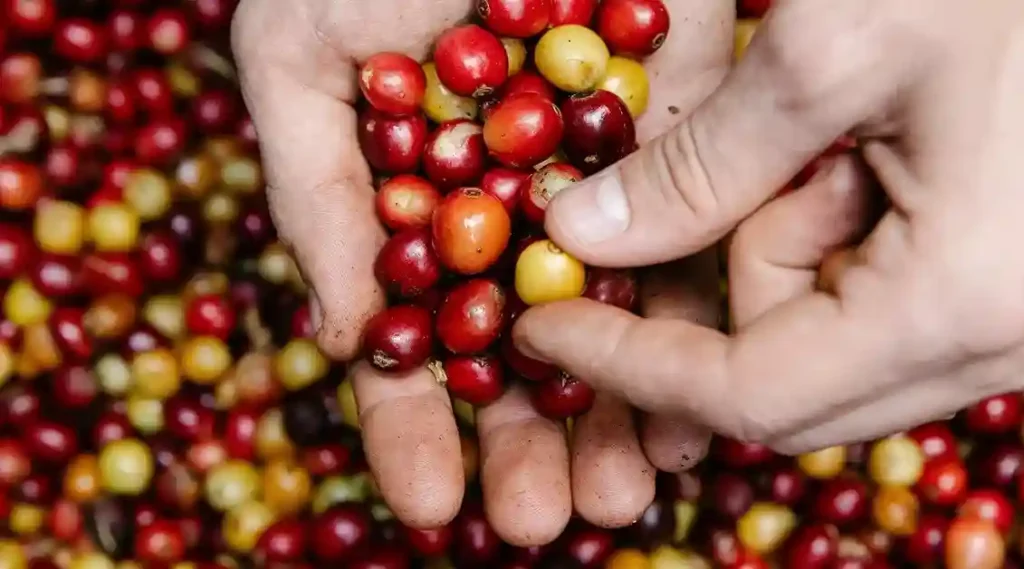What is Arabica and its features
Arabica(Coffea arabica) is the most valuable type of coffee tree. This crop originates from Ethiopia and thrives at altitudes above 1000 meters. The plant has oval leaves, white, fragrant flowers, and berries that contain two beans each. Arabica is distinguished from Robusta by its mild flavor, pronounced acidity, lower caffeine content, and rich, complex aroma profile. Arabica is chosen by true connoisseurs and is the basis of the modern specialty coffee segment.
Popular Arabica coffee varieties in the world
Among the hundreds of varieties of Arabica, the most famous are Typica and Bourbon, the basic coffee varieties.
Typika has a clean, sweet flavor, and its breeding varieties (for example, Blue Mountain) are valued for their mildness.
The Bourbon variety has a rich body and bright acidity; its mutations – Caturra, Catuai, Mundo Novo – are adapted to different climatic conditions.
Hybrids created by breeders to combine high quality flavor with high yields, grain size, and disease resistance are also popular, such as Pacamara and Maragotipe, SL28, Castillo, and Ruiru 11.
The modern market prefers regions of origin with a distinct and predictable flavor profile of varieties:
Colombia(Medellin Supremo, La Macarena, Monteblanco). Fruity, floral, bright notes, ideal for alternative brewing methods.
Burundi (Burundi Businde). Juicy tones of peach and white grapes.
Ethiopia(Sheka, Yirgacheffe, Guji Anaerobic). Nectarine and rose palette, tea and jasmine sound, interesting tea notes.
Guatemala (Huehuetenango). Aromas of dark chocolate and flowers.
Brazil (Piberi). Chocolate. Pear and grapefruit notes.

Geography of cultivation
There is such a thing as a coffee belt. It stretches between 23° north and 25° south latitude. It is here that Arabica coffee grows, which requires special conditions: an altitude of more than 1,000 meters, a temperate climate, temperatures of 15-24°C, sufficient rainfall and fertile soil.
Central and South America are the leading regions for growing coffee trees that produce fruit with bright fruity and nutty notes. African plantations in Ethiopia, Kenya , and Rwanda are known for the rich floral aroma of their beans. In Asia (India, Indonesia, Vietnam), Arabica has earthy and spicy flavors.
Terroir has a significant impact on the flavor profile, making coffee varieties unique. Growing Arabica coffee in different regions provides a wide range of flavor variations.
Effect of altitude and climate on grain quality
The altitude of cultivation is key to the quality of Arabica coffee. High altitude grows more slowly, allowing the beans to accumulate more sugars and flavors. Fertile, well-drained soils are the basis for plant health. Temperatures between 15 and 24°C and regular rainfall create ideal conditions for the development of the plants that give us the best coffee. Seasonality affects the harvest: dry and wet periods help to better control the ripening of berries and the quality of the beans. The length of daylight hours and air humidity are also important, as they shape the unique flavor profile of each batch of beans. In addition, the local microclimate and natural barriers protect coffee trees from diseases and pests, which ultimately improves the flavor of the beans.
Taste characteristics of different types of coffee
Each variety of Arabica has its own unique flavor profile, which is formed by the balance of acidity, sweetness, bitterness and aromatic notes. The acidity varies from bright citrus to mild wine. Sweetness is manifested in shades of caramel, honey or chocolate. Bitterness is usually moderate, which harmoniously complements the overall perception. Aromas can be fruity (berry, citrus), floral (jasmine, lavender), nutty or spicy. The body of the drink can be either light or more intense with a long aftertaste. These characteristics make Arabica the best coffee for many coffee lovers around the world.
Grain processing and its impact on flavor
Processing methods have a significant impact on the final flavor of Arabica coffee. The dry method involves drying the berries in the sun, which produces a richer and more complex fruity flavor profile.
Fermentation is the key stage that makes coffee more complex and shapes the flavor of the future drink. The richness, depth, and harmony of the flavor depend on the proper control of the process.
The washed processing method involves fermenting coffee berries in water after removing the pulp. This gives the coffee a clean flavor and bright acidity. The combined processing method combines both approaches, balancing sweetness and acidity.
There are also new, experimental processing methods that open up unusual flavor shades.

Degrees of roasting
Roasting significantly affects the flavor characteristics of the beans.
Light roasting preserves bright acidity, hints of fruit and flowers.
Medium roasting balances acidity and bitterness, revealing the depth of flavor.
The dark roast intensifies the bitterness, creating a rich, intense flavor with chocolate or caramel notes.
Knowing the nuances associated with roasting helps you decide on the beans and the method of preparation.
High quality criteria
High-quality Arabica coffee is distinguished primarily by the appearance of the beans: they should be uniform in size, free of chips, spots, and defects.
The origin of the grain also matters. Certifications (Organic, Fair trade) guarantee compliance with standards and high quality.
It is recommended to use the coffee within a month of roasting to preserve the aroma and flavor.
Appropriate packaging has a major impact on freshness. For example, vacuum bags or packaging with a gas vent help to avoid oxidation of the grains.
Tips for choosing coffee for your home
When choosing arabica for your home, it is important to determine what you expect from your coffee. Do you like more sour, fruity coffee, or rich and sweet.
The value for money is important: the best-tasting coffee does not always mean the most expensive, so pay attention to the seller’s reviews and reputation. It is better to buy coffee in specialized stores or online, paying attention to the availability of certificates.
Read the labels on the packaging. The roasting date, country of origin, coffee variety and processing method will tell you whether the coffee meets your expectations. You should also consider the degree of roasting and grinding. By considering all these factors, you will find the coffee that best suits your personal preferences.

Methods of preparing different varieties of arabica
Arabica coffee is known for its versatility in brewing methods, which allows you to maximize its unique flavor and aroma.
Speshelti connoisseurs appreciate espresso made from single-origin Arabica for its purity of flavor, bright acidity, and complexity, while commercial blends, especially in Italy or France, often add Robusta to enhance bitterness, body, flavor stability, and cream.
Espresso variations include ristretto, dopio, lungo, and americano, which differ in the amount of water and flavor intensity.
Alternative methods, such as pourover, cakes, French press, and aeropress, help to obtain a lighter, cleaner, and more balanced flavor with bright fruity or floral notes.
It’s important to choose the right grind: fine for espresso, medium for filter coffee, and coarse for French press.
For best results, use clean water and freshly roasted beans.
Storage at home
Proper storage guarantees delicious, freshly ground, aromatic coffee every morning.
It is important to keep coffee in a cool, dark, and dry place, avoid storing coffee near strong-smelling foods, and avoid moisture and sudden temperature changes, as these quickly deteriorate the quality of the beans and reduce the richness of the flavor.
Airtight containers with special degassing valves that release gas but do not allow air to enter are ideal. Opened bags should be used within 1-2 weeks, when the coffee is at its most flavorful and unoxidized.
It is not recommended to store coffee in the refrigerator because of the possibility of absorbing foreign odors. In addition, sudden temperature changes quickly deteriorate the quality of the beans and affect the aroma profile.
To always have a fresh, flavorful product, it is better to buy coffee in small packages.
These simple rules help to keep the arabica fresh, tasty and aromatic to enjoy a cup of the best coffee again and again.






